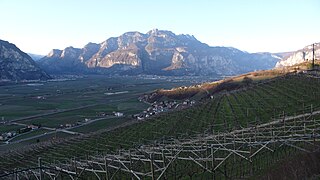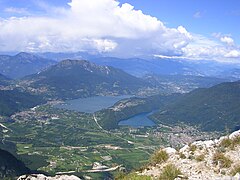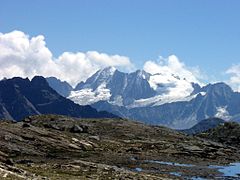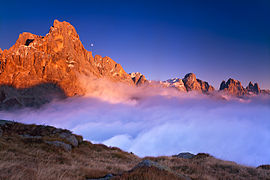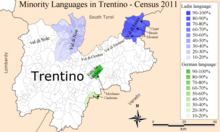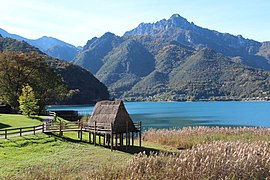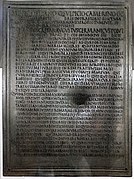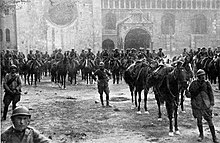Trentino
| Autonomous Province of Trento Provincia autonoma di Trento |
|
|---|---|

|
|
| State : | Italy |
| Region : | Trentino-South Tyrol |
| Capital: | Trent |
| Area : | 6,206.90 km² ( 8. ) |
| Residents : | 542,739 (Dec. 31, 2019) |
| Population density : | 87.4 inhabitants / km² |
| Number of municipalities: | 166 |
| License plate : | TN |
| ISO-3166-2 identification : | IT-TN |
| Governor : | Maurizio Fugatti ( Lega ) |
| Website: | deutsch.provincia.tn.it |
The Trentino officially, Trentino ( Italian Provincia Autonoma di Trento ), a province in the north of Italy and the southern part of the region Trentino-Alto Adige . The province received its autonomy in 1972 through the Second Statute of Autonomy , with which the region was deprived of power and the autonomy was passed on to the provinces of Trento and Bolzano - South Tyrol . The province has 542,739 inhabitants (as of December 31, 2019), a total area of around 6,200 square kilometers and is divided into 166 communities with 15 valley communities . The Trentino is also part of the European region Tyrol – South Tyrol – Trentino , which essentially corresponds to the area of the Kronland Tyrol of the former Austrian Empire and the subsequent Austro-Hungarian monarchy .
The largest city and seat of the autonomous state government is Trento , which is best known for the council held in the 16th century . The Trentino Tourist Association has been promoting a butterfly as a trademark since 1989, since the outlines of the Trentino are similar to one. A comparison is made by Cesare Battistis , who at the end of the 19th century already described the shape of the country with that of a butterfly. The Adamello-Brenta Nature Park , the mountain landscape rich in lakes and, last but not least, the numerous ski areas, including Madonna di Campiglio , have given the province a tourist boom in recent decades.
Names
The name Trentino originally referred to the area around the city of Trento from the 17th century (oldest evidence 1670). The inhabitants of the city were called Trentini . Since the 19th century, in the course of the secessionist efforts of Italian nationalists from Tyrol and Austria , the name was extended to the entire area of the two Tyrolean districts of Trento and Rovereto. The two districts established in the course of the administrative reform of 1803 included the closed Italian- populated areas of Tyrol, the Ladin Fassatal and other linguistic islands inhabited by Ladins and Germans . Essentially, it meant the area of today's Autonomous Province of Trento .
The name Trentino was first used in the national political sense in 1810 by the lawyer and former court chancellor of the Bishopric of Trento, Francesco Vigilio Barbacovi. The terms Trentino and Trentini were popularized in the Vormärz , in particular with the travel guide of the priest Gioseffo Pinamonti, who came from Nonsberg , from 1836, and used by the Italian national movement from 1866 in general in the national political contrast to Tyrol and Tyrol .
In a similar way, the German-speaking side used the term Welschtirol (also Welsch-Tirol ), Welsch-Südtirol or simply South Tyrol for today's Trentino in unofficial linguistic usage in order to distinguish the Italian- from the German-speaking part of Tyrol and any Italian claims on this part of Tyrol also to curb linguistically. The emerging nationality conflict found its expression in the choice of the country's name and in the course of the 19th century Italian-minded people increasingly referred to themselves as Trentini and Austrian-minded people as Tyroleans .
The name Tirolo Meridionale , which corresponds to South Tyrol , lives on in the name of the Schützenbund Compagnie Schützen del Tirolo Meridionale . The affiliation to Alttirol is also emphasized in the name of the PATT ( Partito Autonomista Trentino Tirolese ), a regional party that is concerned with autonomy.
Officially, the area bears the name Autonomous Province of Trento , colloquially it is usually referred to as Trentino . The designation was given official significance in the name of the Trentino-Alto Adige region established in 1948 , since 1972 the Autonomous Region of Trentino-Alto Adige .
In minority languages Trentino is officially certified as Provinzia Autonoma de Trent (on Ladin ), Sèlbstendig Provintz vo Tria (on Cimbrian ) and Autonomous Province va Trea't (on Mocheno called).
geography
Geographical location
The Trentino is located in the central northeast of Italy and forms part of the Brenner axis from the Salurner Klause in the north to about 15 km before the Veronese Klause in the south . In the north it borders on South Tyrol , in the east, south-east and south on the Venetian provinces of Belluno , Vicenza and Verona , and in the west and extreme north-west on the Lombard provinces of Brescia and Sondrio .
West of Rovereto , Trentino has access to the north shore of Lake Garda , which it shares with the provinces of Verona and Brescia. In addition, it is part of the World Heritage Dolomites , the Brenta group of which lies entirely in the Trentino in the west of the province, while the Rosengarten group , the Latemar , the Marmolada and the Pala group in the north-east partly belong to the Trentino.
Landscape image
Large parts of the Trentino are covered by a forested mountainous landscape, with the peaks - with the exception of the south of the country - usually on the other side of the tree line . The plateaus, on the other hand, are used as extensive pastures for alpine pastures. In addition, there are a number of lakes of Ice Age origin in Trentino, which are scattered throughout the province and embedded in various locations. There are almost 300 in number - around 10% of all lakes in the entire Alpine region - with a total of around 35 km² of water.
The natural area of Trentino can be roughly divided into five valley systems , the streams of which partly belong to different river systems and which are intertwined with their respective side and side valleys in different complexities. The Adige Valley forms something like the central backbone and is divided from north to south into the cultural landscapes of the Rotaliana Plain , Trento Basin and Vallagarina . The north-western valley system stretches from the Tonale Pass through Val di Sole and then through the wide-open Non Valley to the Rotaliana plain and is mostly flowed through by the Nonsbach , the tributary of the Adige with the most water. From the northeast, on the other hand, the Avisio has made its way from its source on the Marmolada through the Fassa Valley , the Fiemme Valley and finally the Cembra Valley to the Adige, into which it flows at Lavis . To the east of Trento, across the Marzola watershed, the Valsugana stretches between Lake Caldonazzo and Enego . It is traversed by the Brenta , whose course has its origin at the outflow of the Caldonazzo lake and which forms its own river system, which is mainly fed by mountain streams south of the Lagorai group in the upper reaches of the Valsugana . Finally, the most complex and diverse valley system in the province is formed by the south-western valleys in the area of Judicaria and the Valle dei Laghi. The Inner Judicariums and the Valle dei Laghi form two parallel main valleys, which the Sarca River connects through a side valley of the Outer Judicarians to finally flow into Lake Garda in the lower Sarca Valley near Torbole . Incidentally, the lower Sarcatal and Vallagarina are the deepest valleys in the Alps.
Larger towns and cities are concentrated along the valleys, with the Adige Valley by far the most densely populated and appropriately built up. The lower Sarcatal, in which the places Riva del Garda , Arco and Torbole have grown together to form an almost entirely urbanized area, as well as the Valsugana , also have a high population density .
Mountains and plateaus
The mountains of Trentino belong to the southern Rhaetian Alps and the Dolomites . They consist mainly of limestone and dolomite and are divided into the Adamello, Presanella and Brenta groups, the Judiciary Alps, the Dolomites, the Lessin Alps and the Sette Comuni. 60 percent of the provincial area is above the 1000 m limit. The highest mountain in Trentino is Monte Cevedale ( 3769 m slm ) in the Ortler group , other important peaks are:
- Palon de la Mare ( 3704 m slm )
- Punta San Matteo ( 3684 m slm )
- Presanella ( 3556 m slm )
- Monte Carè Alto ( 3462 m slm )
- Marmolata ( 3342 m slm )
- Cimon della Pala ( 3184 m slm )
- Cima Tosa ( 3173 m slm )
- Cima Brenta ( 3150 m slm )
Nature reserves
Over a third of the total area of Trentino is under nature protection or landscape protection. Over 3700 species of plants and animals are found in Trentino, including the brown bear . In addition to the southeastern part of the Stilfserjoch National Park in the province of Trento, the province also includes the two nature parks Adamello-Brenta and Paneveggio - Pale di San Martino . There are also 143 designated Natura 2000 protected areas , 42 biotopes established by the province and 223 biotopes established by the municipalities. In 2015, the Biosphere Reserve Alpi Ledrensi e Judicaria in the southwest of the province was recognized by UNESCO
administration
Valley communities
Similar to South Tyrol, the Trentino is divided into communities, which since 2010 are no longer called district communities , but valley communities (Italian: Comunità di valle ). In the course of this territorial reform, the number has increased from 11 to 15 communities. The former district community of Valle dell'Adige has been abolished. Its functions are partly carried out by the state capital Trento and the municipalities of Aldeno , Garniga Terme and Cimone to the southwest of Trento , which have not been assigned to any valley community in the form of an intermunicipal administrative cooperation under the name Territorio della Val d'Adige .
| Valley community | German name | Administrative headquarters | surface | population |
|---|---|---|---|---|
| Alta Valsugana e Bersntol | Upper Suganertal and Fersental | Pergine Valsugana | 360.12 km² | 54,453 |
| Alto Garda e Ledro | Upper Lake Garda and Valle di Ledro | Riva del Garda | 353.31 km² | 50,582 |
| Altipiani Cimbri | Cimbrian plateau | Lavarone | 106.15 km² | 4,551 |
| Valle di Cembra | Zimmerstal | Cembra Lisignago | 135.34 km² | 11,169 |
| Fascia | Fassa Valley | San Giovanni di Fassa | 317.85 km² | 10,056 |
| Paganella | Andalo | 97.85 km² | 4,921 | |
| Primiero | Primor | Primiero San Martino di Castrozza | 413.39 km² | 9,899 |
| Rotaliana-Koenigsberg | Mezzocorona | 94.40 km² | 29,978 | |
| Val di Fiemme | Fiemme Valley | Cavalese | 414.70 km² | 20,078 |
| Val di Non | Val di Non | Cles | 597.12 km² | 39,420 |
| Val di Sole | Sulzberg | Times | 611.57 km² | 15,650 |
| Vallagarina | Lagertal | Rovereto | 622.76 km² | 90,891 |
| Valle dei Laghi | Vallelaghi | 139.61 km² | 10,873 | |
| Giudicarie | Judiciaries | Tione di Trento | 1,175.18 km² | 37,335 |
| Valsugana e Tesino | Suganertal and Tesino | Borgo Valsugana | 577.99 km² | 27,190 |
As of January 1, 2017
Communities
The Autonomous Province of Trento has 166 municipalities (as of January 2020). The number is declining due to incorporations and mergers, for example in 2009 there were still 217 municipalities. The largest of these are:
| local community | population |
|---|---|
| Trent | 118.902 |
| Rovereto | 40,285 |
| Pergine Valsugana | 21,548 |
| Arco | 17,927 |
| Riva del Garda | 17.602 |
| Mori | 9,993 |
| Lavis | 9.113 |
| Ala | 8,808 |
| Levico Terme | 8,133 |
- As of December 31, 2019
languages
In contrast to South Tyrol, Italian or a mixed Italian dialect is mostly spoken in Trentino . There is no uniform Trentino dialect. In the west, Lombard influences are noticeable, in the east, especially in the Primiero region and in the lower Suganertal, Venetian dialects are spoken. In between there is a linguistic transition area, which also includes Trento; this Trentino dialect is also most strongly influenced by the Venetian. Words derived from German or Bavarian appear in the Trentino dialect .
German dialects, which can be assigned to Bavarian, are spoken in the language islands of the Zimbern (Italian Cimbri ) and Fersentaler (Italian Mocheni ), which are each recognized as independent languages. While Cimbrian is still spoken by almost the entire village population in Luserna / Lusern , it died out in Lavarone / Lafraun / Lavróu and Folgaria / Vielgereuth / Folgrait in the first half of the 20th century. Heels talers are spoken in Fierozzo / Florutz / Vlarötz, Palù del Fersina / Palai im Fersental / Palae en Bersntol and Frassilongo / Gereut / Garait, including Roveda / Eichleit / Oachlait. The German language is also spoken by part of the population in the municipality of Ruffrè-Mendola / Ruffreit-Mendel, which is in the immediate vicinity of South Tyrol. In addition, German or Ladin was spoken in large areas of Trentino until the early 19th century.
The language border ran around 15 kilometers south of Salurn at the confluence of the Noce (German Ulz) and Avisio (German Efeis) into the Adige until around 1800 . The entire area to the left of the Adige, including the city of Trento (with the exception of the valleys on the Avisio and the court Ivano in the Lower Valsugana ) had a German majority or a strong German minority from the 11th to 17th centuries, and in some cases beyond. The Cembra Valley , Fleimstal (excluding the German towns of Altrei and Truden ) as well as the Nonsberg (excluding Deutschnonsberg ) and the Sulzberg were Ladin.
The Italian Trentino emerged in its compact form today through an intensive phase of Italianization through ethnic homogenization from the middle of the 18th century.
In some valleys, especially in the Fassa Valley (Lad. Val de Fascia ), the Ladin language is in use. Recognized Ladin communities are Campitello di Fassa / Ciampedel, Canazei / Cianacei, Mazzin / Mazin, Moena , Pozza di Fassa / Poza, Soraga / Sorèga, Vigo di Fassa / Vich. On the Nonsberg (Lad. Val de Non ) and occasionally on the Sulzberg (Lad. Val de Sol ) the idioms Nones and Solander are spoken, whose recognition as Ladin has so far been unsuccessful.
Since the 2001 census, the citizens of Trentino have been able to indicate that they belong to a linguistic minority - Ladin, Heelsental or Cimbrian. At the last census in 2011, for the first time more Ladins declared themselves in Val di Non than in Val di Fassa.
| minority | 2001 number of speakers |
2001 share of the total population |
2011 number of speakers |
2011 share of the total population |
|---|---|---|---|---|
| Ladin | 16,462 | 3.5% | 18,550 | 3.5% |
| Heel mentally | 2,276 | 0.5% | 1,660 | 0.3% |
| Cimbrian | 882 | 0.2% | 1,072 | 0.2% |
history
From prehistory to antiquity
Together with South Tyrol, Trentino represents the connecting region between the Mediterranean and the circumalpine region. The settlement of the Trentino begins - except for rare Middle Paleolithic traces - in the late Paleolithic. Settlement zones can be distinguished in the mountains and in the valley, with only ten of over 200 sites in the valley. This can be explained by the massive valley deposits. The valley discovery sites in the Adige Valley are 23 abrises with extensive stratigraphy, which goes back to the early Mesolithic and increased in the late Mesolithic (settling down). During the Neolithic era, the rock roofs were initially abandoned and outdoor stations were preferred. Phase 2 of the Vasi-a-bocca-quadrata culture (VBQ) could be detected for the first time in Isera in the locality of Torretta for this time horizon .
The mighty sequence of layers with five horizons consisted of:
- VBQ 3 with incised and engraved decorations (in Isera 1)
- VBQ 3 with decorations with Chassey influences (in Isera 2) and Fiavè -Castelaz di Cagnò (in Isera 3 and 4)
- as well as ceramics with smooth strips of the Tamins-Carasso type (Isera 5).
In Isera 1 and 2, hilltop settlements were settled in strategically favorable locations for the first time. In Isera 3 and 4 demolitions were also used again. Wet soil settlement appears as a new type of settlement. Isera 5 brought the impoverishment of ceramics and their decorative elements. The spread of metallurgical activity became characteristic. Most of the rock roofs were used again, but in connection with transhumance , copper processing and for grave facilities. The impoverishment of the ceramic forms was explained as a consequence of the mobility that was now necessary.
Since the 1st century BC, the area of what is now Trentino came under Roman rule. It is unclear whether the place Tridentum (Trient) is a Celtic or Rhaetian foundation. It has been documented since the 1st century BC. Around 50 to 40 BC Tridentum was raised to a Roman Municipium and, according to the Roman administrative structure, the surrounding country was assigned to the Municipium as territory. The area of the Roman town consisted largely the territory of the present province of Trento except the Lower Valsugana , Primiero and the Fassa Valley , but including the Bassa country with Bolzano and the Adige valley to the confluence of the register into the Adige and the Isarco Valley to the confluence of the Tinnebaches in the Eisack south of Klausen .
Abri, Busa dell'Adamo , Mesolithic
Statuary menhirs Arco, Copper Age
Tabula Clesiana 46 AD
Middle Ages and Early Modern Times
The area was in the 4th / 5th. Christianized in the 19th century and became the seat of the bishopric of Trento. At the end of the year 400 Bishop Vigilius suffered martyrdom in the Val Rendena. He is counted as the third bishop of Trent from 385 to 400 .
After the collapse of the Western Roman Empire , today's Trentino came under the rule of the Ostrogoths . In 568/569 the conquest by the Lombards followed . They established the Lombard Duchy of Trento on the area of the former Municipium Tridentum , which was one of the most important of the Longobard Empire. As early as the 7th century, the area from Bozen north of Branzoll and on the left of the Adige to the Passer had to be ceded to the Baiern .
With the incorporation of Langobardia Maior 774 into the Frankish Empire under Charlemagne , the Carolingian administrative division was introduced. The Lombard duchy became the Franconian county of the Lombard crown .
In 952 Otto I , King of Eastern Franconia , from 951 also King of Italy and later Emperor, separated the margraviate Verona from the Regnum Italicum and incorporated it into the tribal duchy of Baiern , including the county of Trento, which became part of the Regnum Teutonicum . From this time, after the Lombard immigration of the 6th century, German, mainly Bavarian settlement activity began in parts of what is now Trentino and beyond.
The county of Trento was given to the Bishop of Trient as a fiefdom in 1027 by Emperor Konrad II as part of the imperial church system within the Duchy of Baiern . At the same time, the bishop was made imperial prince . The most important passes to imperial Italy led through the alpine southern part of the Duchy of Bavaria . The German kings and Roman-German emperors saw them more securely in the hand of the bishops than in that of a possibly rebellious nobility.
In the north, the Counts of Eppan and Ulten, who were related to the mighty Welfs , brought under their control the parts of today's South Tyrol located between the Töll near Meran and the Salurner Klause on the right of the Adige and withdrew them from the Prince-Bishops of Trento. After their extinction in 1250, the Ultental , middle Etschtal , Überetsch and Unterland passed to the Counts of Tyrol , who had also been the governors of the bishopric of Trento since 1150 . Other parts, such as the area south of Salurn to the confluence of Noce and Avisio , came directly to the County of Tyrol , as did lords on the Nonsberg , in the Fiemme Valley and in the Valsugana . 1282 became the County of Tyrol the Imperial City and retired from the Duchy of Bavaria from.
In 1363, the county of Tyrol was inherited by the Habsburgs , as did their office as hereditary bailiffs of the monasteries of Trento and Brixen . In the compacts , also concluded in 1363 by Rudolf IV and the Prince-Bishop of Trient , which were subsequently renewed several times in a modified form, Habsburg secured its sphere of influence on the Prince-Bishopric of Trento, which was still directly imperial.
The eastern parts of today's Trentino only partially belonged to the spiritual principality of Trento. The Fassa Valley became part of the Bressanone Monastery in the 11th century and was part of the Duchy of Baiern before 952, while the Lower Valsugana and Primiero were part of the Feltre Monastery . The areas of Feltres were won for Tyrol by the Habsburgs in the 14th century. After Venice's urge to expand northwards, which had begun in 1410, was halted with the Battle of Calliano south of Trento in 1487 , the Venice-occupied territories of the bishopric of Trento came under the reign of Emperor Maximilian I after the defeat of the lagoon republic in the Battle of Agnadello in 1509 back to the prince-bishopric. Maximilian gave some of these areas on the left bank of the Adige, some of which were populated by Germans, back to the prince-bishops, some of them as "Welsche Confinen" to secure the border against Venice directly to the county of Tyrol.
Modern
The ecclesiastical imperial principality was mediatized in 1803 with the Reichsdeputationshauptschluss and administratively incorporated into the County of Tyrol.
From the territory of today's Trentino belonged before 1803
- 54.1% to the Hochstift Trento (with 57.8% of the then residents)
- 40.8% to the county of Tyrol (40.6% of the population)
- and 5.1% to the Brixen monastery (1.6% of the population).
With the Peace of Pressburg , the area known as Tirolo meridionale , Welschtirol or Tirolo italiano was assigned to Bavaria, which was allied with Napoleon I in the Third Coalition War, after Austria's defeat in the Battle of Austerlitz in 1805 . In the course of the Bavarian administrative reform of 1808, the two Austrian districts of Rovereto and Trient were combined into the Etschkreis and thus today's Trentino for the first time in a single administrative unit. In 1809, Welschtirol took part in the Tyrolean struggle for freedom under Andreas Hofer . After Napoleon's victory in the Battle of Wagram and the Peace of Schönbrunn , French and allied troops again occupied Tyrol. In February 1810, Napoleon Bonaparte separated the Etschkreis from Bavaria and incorporated it as Dipartimento Alto Adige into the northern Italian kingdom of Italy, which was governed by his son-in-law Eugène Beauharnais . Likewise a part of the Bavarian Eisackkreis around Bozen including the South Tyrolean Unterland. In 1813 the Tyroleans liberated themselves from Italian-French rule in a popular uprising. At the Congress of Vienna in 1815, what is now Trentino officially became part of Tyrol and Austria again .
After 1815, parts of the nobility and bourgeoisie, especially freelancers, were captured by the Italian national movement. They claimed that Welschtirol belonged entirely to the Hochstift Trient before 1803 and had only recently been made part of Tyrol against its will. In addition, Welschtirol is uniformly inhabited by Italians. The fact that parts of the Trentino belonged to the County of Tyrol and the Brixen monastery before 1803 was denied, as was the Ladin and German-speaking presence.
During the Risorgimento in the first Italian War of Independence in 1848, Italian free corps advanced as far as Vezzano about 10 kilometers from Trento until they could be stopped by Austrian troops. In the Third Italian War of Independence in 1866, Italian free troops moved against Trento from two directions. In the Battle of Bezzecca , the troops under Giuseppe Garibaldi were able to defeat the Austrians as well as the troops led by Giacomo Medici in the Valsugana . The ceasefire in the German War , imposed by Prussia at the same time, prevented the Italian allies from advancing further and led to the withdrawal of Italian troops from Trentino. The result was that even after the war of 1866, after which the Habsburgs had to evacuate Veneto , Trentino remained under the rule of Austria-Hungary .
In the course of the 19th century, economic problems became increasingly noticeable, which led to the impoverishment of the country's predominantly rural population. These problems were partly homemade, but partly also due to external factors. The management style of an ancien régime, which was shaped by the prince-bishopric for centuries, and its encrusted administrative apparatus turned out to be a hindrance after incorporation into the Habsburg Empire and its comparatively modern state apparatus, which had an even greater effect in a traditionally oriented society. With the disappearance of Lombardy and Veneto and the new state border in the south, not only was it difficult to export and import goods to these nearby markets, but also a barrier to the neighboring Italian-speaking cultural area was built. The latter found its expression in the struggle for its own Italian university, which culminated in the so-called “ Fatti di Innsbruck ”.
Agricultural production, which was lagging behind due to the geographical conditions and the strong fragmentation of property and which only allowed changes to a limited extent, if at all, was also a factor that had an increasingly negative impact. In addition, a number of natural events occurred in the course of the 19th century that exacerbated the already tense situation, such as the severe floods of 1882 and 1885, the outbreak of foot and mouth disease in the 1890s, which drastically reduced the number of livestock outbreak of pébrine that the sericulture met or the infestation of the vines through the downy mildew followed by phylloxera in the 1900s. The impoverishment of the rural population could be read from two indicators that became more common between the 19th and 20th centuries. On the one hand there was pellagra , a deficiency disease due to the increased consumption of cornmeal-based cheap but stomach-filling polenta , which was endemic from the 1880s , and on the other hand emigration , which was seen as the last resort out of trouble.
Out of this situation, the desire for more independence and autonomy arose in parts of the population, as promoted, for example, by Alcide De Gasperi . But even more radical currents such as irredentism partly drew their right to exist from this. The latter tried to unite the Trentino with its Italian-speaking population with the newly founded Kingdom of Italy . From 1866 onwards, a radical current of Italian nationalism raised territorial claims beyond the area inhabited by Italians. The main ridge of the Alps was called for as the northern border of Italy, a demand that was directed directly against Switzerland and above all against Austria. After the armistice of Villa Giusti at the end of the First World War , Trentino was occupied by Italian troops and in the subsequent Treaty of Saint-Germain on October 10, 1920, it was annexed to the Kingdom of Italy. At the same time, the annexation of German South Tyrol and the part of Tyrol inhabited by Ladins took place . Shortly before Italy entered the war, Alcide De Gasperi, as a member of the Austrian Imperial Council, had expressed the certainty to the Austrian ambassador in Rome, Karl von Macchio , that 90 percent of Tyrol's Italians would vote in favor of staying with Austria in a referendum. During the First World War, around 60,000 Welschtiroler fought in the ranks of the Austro-Hungarian Army against Italy and on the Eastern Front; Over 11,000 soldiers lost their lives in the process. Around 750 Trentinians deserted and fought in the ranks of the Italian army against Austria.
After the First World War, the newly annexed areas of Tyrol were administered as Venezia-Tridentina by an Italian civil commissioner. When Italian fascism came to power on January 21, 1923, the province of Trento was established, to which the Ladin regions and South Tyrol were also subject. In the same year the Ladin valleys Ampezzo and Buchenstein (Ladin Fodom , Italian Livinallongo ) were attached to the province of Belluno . In 1927, with the establishment of a separate province of Bolzano, most of South Tyrol was separated from the province of Trento. The South Tyrolean Unterland and the German-speaking communities of the Fiemme Valley and the Deutschnonsberg remained near Trento. In 1929 Pedemonte was spun off from the Province of Trento and added to the Province of Vicenza . In 1934 the municipalities of Valvestino and Magasa were annexed to the province of Brescia .
With the German occupation of Italy in World War II, the former Tyrolean territories of Italy were not separated from Italy in September 1943, but with the Operational Zone Alpine Foreland (OZAV) they were placed under German civil administration. The German-speaking communities of the Province of Trento with the exception of the language islands were united with the Province of Bolzano.
After the Second World War, Trentino, especially the city of Trento, played an important role within the newly founded region of Trentino-Tyrolean Etschland . Italy's Prime Minister Alcide De Gasperi , himself a Trentino from Pieve Tesino , ensured that his compatriots were granted extensive autonomy, which was originally only intended for South Tyrol. The regional government in Trento, where the Italians were in the majority, was also largely responsible for the concerns of the South Tyroleans, which caused displeasure among them because it circumvented the self-government of South Tyrol promised in the Gruber-De-Gasperi Agreement . After the statute of autonomy of 1972 , the Trentino retained its autonomy and in some cases even expanded it: However, it has been almost completely decoupled from South Tyrol and the region only has a coordinating function between the provinces. At Tesero in Val di Stava on July 19, 1985 the dam of a sedimentation basin of a mine broke and caused a tidal wave that claimed 268 lives. In 1976 and 1998 two serious accidents occurred in the town of Cavalese on the cable car leading to Monte Cermis. In the immediate post-war period, Trentino was still a remote, predominantly agricultural region, but experienced a considerable economic boom in the following years of the miracolo economico (economic miracle) like the neighboring regions of South Tyrol, Veneto and Friuli and is now one of the most economically successful and wealthy in Italy.
Population development
| year | 1921 | 1971 | 1981 | 1991 | 2001 | 2011 |
|---|---|---|---|---|---|---|
| Residents | 404.237 | 427.845 | 442.845 | 449.852 | 477.017 | 524,832 |
Source: Istituto di Statistica della Provincia di Trento - ISPAT
In the past there have been significant changes in the demographic development in Trentino. While emigration had a negative effect on population growth up until the 1970s, it has no longer played a role since then due to increased prosperity . On the other hand, the decline in the birth rate with simultaneous aging and an increase in the death rate had a negative impact . From this point onwards, the positive balance in the population development is primarily due to immigration , with the lower unemployment rate compared to the rest of Italy being one of the main reasons for immigration.
The population density of 86.8 inhabitants / km² (2016) is due to the geographic conditions, around 60% of the country's surface is over 1000 m slm , unevenly distributed and compared to the nationwide value of 201 inhabitants / km² (2016), significantly lower. In the past, significant internal migration processes could be observed. The population in the altitude range up to 250 m slm has increased sharply since the 1930s. In 1931 it made up 37.4% of the total population, in 2006 it was 49.4%. This increase was due to structural change processes, such as the abandonment of mountain agriculture in favor of the secondary and tertiary sectors.
Autonomy and politics
The Trentino is an autonomous province and accordingly enjoys special rights, which are anchored in the statute of the Trentino-Alto Adige region. The state has extensive competencies in the areas of spatial planning, handicrafts, trade fairs and markets, hunting and fishing, communication and transport, tourism and hospitality, agriculture, kindergartens and school construction.
Large parts of the taxes collected by the state flow back into the state coffers, from value added tax to income and corporation tax. To do this, the country must perform functions (such as the school system) that are carried out by the state in the rest of Italy, and also finance them.
Because of its efficient management and financial advantages, numerous municipalities in the provinces of Belluno and Vicenza have applied for annexation to Trentino.
After the Italian Christian Democrats had government responsibility for decades, there was an alternation of different political constellations after the Mani pulite political scandal .
Governors of Trentino
- 1948–1952: Giuseppe Balista ( DC )
- 1952–1956: Remo Albertini (DC)
- 1956–1960: Riccardo Rosa (DC)
- 1960–1974: Bruno Kessler (DC)
- 1974–1979: Giorgio Grigolli (DC)
- 1979–1985: Flavio Mengoni (DC)
- 1985–1989: Pierluigi Angeli (DC)
- 1989–1992: Mario Malossini (DC)
- 1992–1994: Gianni Bazzanella (DC)
- 1994–1999: Carlo Andreotti ( PATT )
- 1999–2012: Lorenzo Dellai (Margherita, UpT )
- 2013: Alberto Pacher ( PD )
- 2013–2018: Ugo Rossi (PATT)
- since 2018: Maurizio Fugatti (Lega)
Trentino Parliament
The state elections of October 21, 2018 brought the following result:
| candidate | be right | % | Seats | Lists | be right | % | Seats | total | ||
|---|---|---|---|---|---|---|---|---|---|---|
| Maurizio Fugatti | 124,590 | 46.74 | 1 | Lega Nord (LN) | 69,116 | 27.09 | 13 | 21st | ||
| Civica Trentina (CT) | 11,777 | 4.62 | 2 | |||||||
| Progetto Trentino (PT) | 8,248 | 3.23 | 1 | |||||||
| Forza Italia (FI) | 7.204 | 2.82 | 1 | |||||||
| Autonomisti Popolari (AP) | 7,621 | 2.99 | 1 | |||||||
| Agire per il Trentino (AGIRE) | 5,458 | 2.14 | 1 | |||||||
| Unione di Centro - Centro Popolare (UdC – CP) | 5,306 | 2.08 | 0 | |||||||
| Fratelli d'Italia (FdI) | 3,686 | 1.44 | 0 | |||||||
| Associazione Fassa (AF) | 2,490 | 0.98 | 1 | |||||||
| total | 120.906 | 47.39 | 20th | |||||||
| Giorgio Tonini (PD) | 67,712 | 25.40 | 1 | Partito Democratico (PD) | 35,530 | 13.93 | 4th | 8th | ||
| Futura 2018 | 17,670 | 6.93 | 2 | |||||||
| Unione per il Trentino (UpT) | 10.150 | 3.98 | 1 | |||||||
| total | 63,350 | 24.83 | 7th | |||||||
| Ugo Rossi | 33.121 | 12.42 | 1 | Partito Autonomista Trentino Tirolese (PATT) | 32,109 | 12.59 | 3 | 4th | ||
| Filippo Degasperi | 18,922 | 7.10 | 1 | MoVimento 5 digit (M5S) | 18,437 | 7.23 | 1 | 2 | ||
| Antonella Valer | 7,099 | 2.66 | 0 | Liberi e Uguali (LeU) | 3,560 | 1.40 | 0 | 0 | ||
| L'Altro Trentino a Sinistra (AES) | 2,101 | 0.82 | 0 | |||||||
| total | 5.661 | 2.22 | 0 | |||||||
| Mauro Ottobre | 5,237 | 1.96 | 0 | Autonomia Dinamica (AD) | 5.117 | 2.01 | 0 | 0 | ||
| Roberto de Laurentis | 4.015 | 1.51 | 0 | Territorialità Responsabilità Economia (TRE) | 3,826 | 1.50 | 0 | 0 | ||
| Paolo Primon | 2,384 | 0.89 | 0 | Popoli Liberi - Primon Free Peoples | 2,285 | 0.90 | 0 | 0 | ||
| Ferruccio Chenetti | 1,904 | 0.71 | 0 | Moviment Ladin de Fascia | 1,890 | 0.74 | 0 | 0 | ||
| Filippo Castaldini | 1,247 | 0.47 | 0 | CasaPound Italia (CPI) | 1,215 | 0.48 | 0 | 0 | ||
| Federico Monegaglia | 350 | 0.13 | 0 | Riconquistare l'Italia (RI) | 341 | 0.13 | 0 | 0 | ||
economy
Agriculture plays an important role in Trentino: the production of apples of the Golden Delicious variety is particularly important here. Wine production is also significant.
Industry employs around 33% of the working population. Many companies are active in the textile, wood processing and printing industries.
The most important branch of the economy is the service sector. Every tenth Trentiner is employed by the provincial administration. The role of tourism is outstanding. The tourist centers are initially Trento itself, then the winter sports resorts Madonna di Campiglio , Canazei and San Martino di Castrozza , the climbing center Arco and the windsurfing center Riva del Garda .
The nominal per capita income in 2015 was 34,600 euros, in terms of purchasing power the Trentino achieved a value of 123 (EU-27 = 100). With a value of 0.916, Trentino ranks first among the 21 regions and autonomous provinces of Italy in the Human Development Index .
literature
- Cesare Battisti: Il Trentino. Saggio di geografia fisica e di anthropogeografia . Giovanni Zippel Editore, Trento 1889.
- Giovanni Francesio, Editor Rolf Eder: South Tyrol & Trentino: Castles - National Parks - Wine - Hikes - Bozen - Merano - Palazzi - Dolomites - Törggelen - Glacier (= A Dorling-Kindersley-Buch; Vis-à-vis ). updated new edition. Dorling Kindersley, Starnberg 2008, ISBN 978-3-8310-0530-7 (Italian: Trentino Alto Adige . 2001. Translated by Benjamin Schwarz, first edition: 2003).
- Michael Gehler: The fatti di Innsbruck or the storming of the Italian law faculty on November 4th, 1904. An event in the overall political context of the Habsburg monarchy coming to an end . In: Michael Gehler, Günther Pallaver: University and Nationalism. Innsbruck 1904 and the storming of the Italian law faculty . Trento 2013, ISBN 978-88-7197-152-0 .
- Aldo Gorfer: Le valli del Trentino: guida geografico-storico-artistico-ambientale Volume 1 Trentino occidentale . Manfrini, Calliano 1975.
- Aldo Gorfer: Le valli del Trentino: guida geografico-storico-artistico-ambientale Volume 2 Trentino orientale . Manfrini, Calliano 1977.
- Giovanni Olmi: La pellagra nel Trentino from otto e novecento . In: Maria Luisa Betri, Ada Gigli Marchetti (eds.): Salute e classi lavoratrici in Italia dall'Unità al fascismo . Angeli, Milan 1982.
Web links
Single receipts
- ↑ Statistiche demografiche ISTAT. Monthly population statistics of the Istituto Nazionale di Statistica , as of December 31 of 2019.
- ↑ The Making of a Trademark in Italian , accessed May 23, 2017.
- ^ Cesare Battisti: Il Trentino. Saggio di geografia fisica e di antropogeografia , p. 19.
- ↑ Michael Mayr: The Italian Irredentism. 2nd increased and improved edition, Innsbruck 1917, p. 261.
- ↑ Francesco Vigilio Barbacovi: Considerazioni sulla prosperità dei popoli del Trentino ora riuniti al Regno d'Italia. Trento 1810.
- ^ Gioseffo Pinamonti: Trento. Sue vicinanze, commercio e costumi de 'Trentini. Trento 1836; to do this. Florian Huber: Religious Ethnographies. Religion, space and nation in pre-March country descriptions . In: Hannes Obermair et al. (Ed.): Regional civil society in motion - Cittadini innanzi tutto. Vienna-Bozen: Folio 2012. ISBN 978-3-85256-618-4 , pp. 12–31.
- ↑ Michael Mayr: The Italian Irredentism. 2nd increased and improved edition, Innsbruck 1917. p. 266.
- ↑ cf. Hans-Dieter Hübner: On the way on historical tracks. Walks and excursions to the priorities of Austria-Hungarian South Tyrol offensive 1916. Volume 3, 2016: ... southern part of the county, was called to 1918 Trento or simply Tyrol ... .
- ^ Anton von Lutterotti: South Tyrolean regional studies. Bolzano: Athesia 2000, p. 7
- ^ Aree protette del Trentino. In: www.areeprotette.provincia.tn.it. Autonomous Province of Trento, accessed June 16, 2020 (Italian).
- ↑ ZSC e ZPS in Trentino. Autonomous Province of Trento, accessed June 16, 2020 (Italian).
- ↑ Riserve naturali provinciali. Autonomous Province of Trento, accessed June 16, 2020 (Italian).
- ↑ Biotopi di interest comunale. Autonomous Province of Trento, accessed June 16, 2020 (Italian).
- ↑ Biosfera UNESCO “Alpi Ledrensi & Judicaria”. Autonomous Province of Trento, accessed June 16, 2020 (Italian).
- ^ Territorio Val d'Adige. In: comune.trento.it. Retrieved July 1, 2020 (Italian).
- ↑ Surface territorial e popolazione resident al 01/01/2017 per comunità di valle. In: statweb.provincia.tn.it. Istituto di statistica della provincia di Trento, accessed on June 29, 2020 (Italian).
- ↑ Bonfadini, Giovanni: Il confine linguistico Veneto-Lombardo. In: Manlio Cortelazzo : Guida ai dialetti veneti. Volume 5. CLEUP, Padua 1983, pp. 23-59.
- ↑ Eg “matèla” from the Bavarian Madel .
- ^ Bernhard Wurzer: The German language islands in Northern Italy. 4. revised Edition, Bolzano 1977.
- ↑ Bepe Richebuono: Breve storia dei Ladini Dolomitici. Istitut Ladin Micurà de Rü, San Martin de Tor 1992.
- ↑ Belonging to the population of Ladin, Heelsentaler and Cimbrian languages, according to municipality and residential area - 2001 census (PDF; 27 kB) Statistical Yearbook (Annuario Statistico) 2006 of the Autonomous Province of Trento.
- ↑ a b Preliminary final result of the 2011 census (PDF; 202 kB), Statistics Office of the Autonomous Province of Trento.
- ↑ Appartenenza alla popolazione di lingua ladina, mochena e cimbra, per comune ed area di residenza (censimento 2001). (PDF; 27 kB) “Minoranze Linguistiche” website of the Autonomous Province of Trento, accessed on October 4, 2012 (Italian).
- ^ Hermann Ignaz Bidermann : The Italians in the Tirolisches Provinzial-Verbande , Innsbruck 1874, p. 61ff
- ↑ Clara Nardon: 1848: irredenti e compromessi: documenti pp. 11-19
- ^ A b Giovanni Olmi: La pellagra nel Trentino fra otto e novecento p. 365–378
- ↑ Michael Gehler: The fatti di Innsbruck or the storming of the Italian law faculty on November 4, 1904. An event in the overall political context of the Habsburg monarchy , in: Michael Gehler / Günther Pallaver: University and Nationalism. Innsbruck 1904 and the storming of the Italian law faculty, Trient 2013, pp. 19–55.
- ↑ Paolo Piccoli, Armando Vadagnini: De Gasperi. Un trentino nella storia d'Europa , Soveria Mannelli 2004, p. 103
- ^ Claus Gatterer : Hereditary enmity between Italy and Austria. Munich-Zurich 1972, p. 138
- ^ Tyrolean Book of Honor - Digital
- ↑ Database of the Trentinians who died in World War I (Italian) , accessed on November 15, 2017.
- ↑ Miria Manzana: Volontari trentini nell'esercito italiano , trentinocultura.net
- ↑ Popolazione residente ai censimenti e superficie territoriale per comunità di valle (1921-2011) ( Italian ) Istituto di Statistica della Provincia di Trento. Retrieved November 16, 2019.
- ↑ L'economia trentina: demografia, occupazione e reddito prodotto - Aspetti demografici (Italian) accessed on November 23, 2018
- ↑ Distribuzione della superficie territoriale per fascia altimetrica (Italian) accessed on November 23, 2018
- ↑ Provincia Autonoma di Trento - Servizio Statistica: Studi monografici: Un'analisi dinamica della popolazione residente in provincia di trento attraverso i censimenti pp. 15-16
- ↑ Eurostat. Retrieved April 15, 2018 .
- ^ Sub-national HDI - Area Database - Global Data Lab. Retrieved August 12, 2018 .
Coordinates: 46 ° 4 ′ N , 11 ° 7 ′ E






